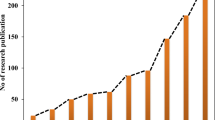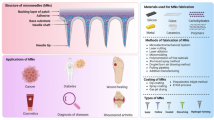Abstract
Transdermal drug delivery offers a number of advantages including sustained release, improved patient compliance, avoidance of gastric irritation, as well as elimination of pre-systemic first-pass effect. However, only few medications can be delivered through the transdermal route in therapeutic amounts. NSAIDs are consisted of a group of drugs that are widely used, but their use by oral or transdermal system is limited due to a number of side effects. Therefore, NSAIDs are ideal candidates for delivery via microneedles, a relatively new method of drug delivery. A new concept was introduced known as microneedles and these could be used to effectively deliver drugs using micron-sized needles in a minimally invasive and painless manner. Microneedles can be used to enhance transdermal drug delivery and they can be fabricated in different forms.
Access this chapter
Tax calculation will be finalised at checkout
Purchases are for personal use only
Preview
Unable to display preview. Download preview PDF.
Similar content being viewed by others
References
A. Davidson, B. Al-Qallaf, D. Brusan Das. Transdermal drug delivery by coated microneedles: Geometry effects on effective skin thickness and drug permeability. Chem. Eng. Res. Des, 2008;86(11):1196–1206.
A. Ling Teo, C. Shearwood, K. Chye Ng, J. Lu, S. Moochhala. Transdermal microneedles for drug delivery applications. Mater. Sci. Eng. B, 2006;132(1-2):151–154.
S. Torbica, G. Vuleta, N. Ignjatović, D. Uskoković. Polimerne nanočestice - nosači za transdermalnu primjenu ljekovitih supstanci. Tehnika-Novi materijali, 2009;18(4):1-14.
K. Cheung, D. B. Das. Microneedles for drug delivery: trends and progress. Drug Deliv, 2016;23(7):2338-2354.
J. Hadgraft, J. du Plessis, C. Goosen. The selection of non-steroidal anti-inflammatory agents for dermal delivery. Int. J. Pharm, 2000;207(1-2):31-37.
A. P. Raphael, G. Gerrastazu, F. Sonvico, T. W. Prow. Formulation design for topical drug and nanoparticle treatment of skin disease. Ther. Deliv, 2015;6(2):197–216.
S. Vučen, N. Pajić Bubić, S. Savić, G. Vuleta. Mikroigle – fizički pojačivači (trans)dermalne isporuke lijekova. Arh. Farm, 2014;64:295-321.
J. E. Grice, T. W. Prow, M. A. F. Kendall, M.S. Roberts. Electrical and physical methods of skin penetration enhancement. In Topical and Transdermal Drug Delivery: Principles and Practise (eds H. A. E. Benson and A. C. Watkinson) John Wiley & Sons, Inc., Hoboken, NJ, USA. 2011:45-47.
J. W. So, H. H. Park, S. S. Lee, D. C. Kim, S. C. Shin, C. W. Cho. Effect of microneedle on the pharmacokinetics of ketoprofen from its transdermal formulations. Drug Deliv, 2009;16(1):52–56.
G. M. Barratt. Therapeutic applications of colloidal drug carriers. Pharm. Sci. Technolo. Today, 2000;3(5):163-171.
G. Cevc, S. Mazgareanu, M. Rother. Preclinical characterisation of NSAIDs in ultradeformable carriers or conventional topical gels. Int. J. Pharm, 2008;360(1-2):29-39.
S. E. Cross, M.S. Roberts. Physical enhancement of transdermal drug application: Is delivery technology keeping up with pharmaceutical development? Curr. Drug Deliv, 2004;1(1):81-92.
D. J. Yadav, K. A. Vaidya, P. R. Kulkarni, R. A. Raut. Microneedles: Promising technique for transdermal drug delivery. Int. J. Phar. Bio. Sci, 2011;2(1):684-708.
K. Mooney, J. C. McElnay, R. F. Donnelly. Children’s views on microneedle use as an alternative to blood sampling for patient monitoring. Int. J. Pharm. Pract., 2014;22(5):335-344.
J. H. Oh, H. H. Park, K. Y. Do, M. Han, D. H. Hyun, C. G. Kim et al. Influence of the delivery systems using a microneedle array on the permeation of a hydrophilic molecule, calcein. Eur. J. Pharm. Biopharm, 2008;69(3):1040–1045.
E. Khafagy, M. Morishita, Y. Onuki, K. Takayama. Current challenges in non-invasive insulin delivery systems: A comparative review. Adv. Drug Deliv. Rev, 2007;59(15):1521–1546.
J. J. Escobar – Chávez, D. Bonilla-Martinez, M. A. Villegas-González, E. Molina-Trinidad, N. Casas-Alancaster, A. L. Revilla-Vázquez. Microneedles: a valuable physical enhancer to increase transdermal drug delivery. J. Clin. Pharmacol, 2011;51(7):964-977.
P. M. Wang, M. Cornwell, M. R. Prausnitz. Minimally invasive extraction of dermal interstitial fluid for glucose monitoring using microneedles. Diabetes Technol. Ther, 2005;7(1):131–141.
J. R. Windmiller, G. Valdes-Ramirez, N. Zhou, M. Zhou, P. R. Miller, C. Jin et al. Bicomponent microneedle array biosensor for minimally-invasive glutamate monitoring. Electroanalysis, 2011; 23(10):2302– 2309.
J. Trzebinski, S. Sharma, A. R. Moniz, K. Michealakis, Y. Zhang, A. E. Cass. Microfluidic device to investigate factors affecting performance in biosensors designed for transdermal applications. Lab. Chip, 2012;12(2):348–352.
J. R. Windmiller, N. Zhou, M. C. Chuang, G. Valdes-Ramirez, P. Santhosh, P. R. Miller et al. Microneedle arraybased carbon paste amperometric sensors and biosensors. Analyst, 2011;136(9):1846–1851.
L. Nordquist, N. Roxhed, P. Griss, G. Stemme. Novel Microneedle Patches for Active Insulin Delivery are Efficient in Maintaining Glycaemic Control: An Initial Comparison with Subcutaneous Administration. Pharm. Res, 2007;24(7):1381-1388.
V. Leeladurga, U. C. Teja, S. K. Sultana, K. Sudeep, V. S. Anusha, T. Han et al. Application of Microneedle Arrays for Enhancement of Transdermal Permeation of Insulin: In Vitro Experiments, Scaling Analyses and Numerical Simulations. AAPS PharmSciTech, 2016;17(4):915-922.
Y. Ito, E. Hagiwara, A. Saeki, N. Sugioka, K. Takada. Feasibility of microneedles for percutaneous absorption of insulin. Eur. J. Pharm. Sci, 2006;29(1):82-88.
S. P. Davis, W. Martanto, M. G. Allen, M. R. Prausnitz. Hollow Metal Microneedles for Insulin Delivery to Diabetic Rats. IEEE Trans. Biomed. Eng, 2005;52(5):909-915.
M. Kaur, K. B. Ita, I. E. Popova, S. J. Parikh, D. A. Bair. Microneedle-assisted delivery of verapamil hydrochloride and amlodipine besylate. Eur. J. Pharm. Biopharm, 2014;86(2): 284–291.
B. N. Nalluri, S. Kosuri, S. S. Valluru, C. T. Uppuluri, A. S. Shaik. Microneedle Assisted Transdermal Delivery of Levodopa. Ind. J. Pharm. Edu. Res, 2016;50(2):287-294.
E. X. Vrouwe, R. Luttge, I. Vermes, A. van den Berg. Microchip capillary electrophoresis for point-of-care analysis of lithium. Clin. Chem, 2007;53(1):117-12.
D. V. McAllister, M. G. Allen, M. R. Prausnitz. Microfabricated microneedles for gene and drug delivery. Annu. Rev. Biomed. Eng, 2000;2(1):289-313.
J. H. Park, M. G. Allen, M. R. Prausnitz. Biodegradable polymer microneedles: Fabrication, mechanics and transdermal drug delivery. J. Control Release, 2005;104(1):51-66.
R. Kumar, A. Philip. Modified Transdermal Technologies: Breaking the Barriers of Drug Permeation via the Skin. Trop. J. Pharm. Res, 2007;6(1):633-644.
S. H. Bariya, M. C. Gohel, T. A. Mehta, O. P. Sharma. Microneedles: An emerging transdermal drug delivery system. J. Pharm. Pharmacol, 2012;64(1):11-29.
M. R. Prausnitz. Microneedles for transdermal drug delivery. Adv. Drug Deliv. Rev, 2004;56(5):581– 587.
A. K. Banga. Transcutaneus Immunisation via Physical Methods in Transdermal and intradermal delivery of therapeutic agents: Application of physical technologies (eds A. K. Banga) Boca Raton, Fl: CRC Press, Taylor & Francis Group, NY, USA. 2011:219-242.
B. Zorec, V. Préat, D. Miklavčič, N. Pavšelj. Active enhancement methods for intra and transdermal drug delivery: a review. Zdrav. Vestn, 2013;82:339-356.
S. Henry, D. V. McAllister, M. R. Praunitz. Microfabricated microneedles: a novel approach to transdermal drug delivery. J. Pharm. Sci, 1998;87(8):922-925.
M. S. Nandagopal, R. Anton, S. Rangabhashiyam, N. Sreekumar, N. Selvaraju. Overview of microneedle system: a third generation transdermal drug delivery approach. Microsyt. Technol, 2014;20(7):1249-1272.
Y. Xie, B. Xu, Y. Gao. Controlled transdermal delivery of model drug compounds by mems microneedle array. Nanomedicine, 2005;1(2):184-190.
H. L. Quinn, L. Bonham, C. M. Hughes, R. F. Donnelly. Design of a dissolving microneedle platform for transdermal delivery of a fixed-dose combination of cardiovascular drugs, J. Pharm Sci, 2015;104(10):3490-3500.
M. B. Brown, M. J. Traynor, G. P. Martin, F. K. Akomeah. Transdermal drug delivery systems: skin perturbation devices. Methods Mol. Biol, 2008;437:119-139.
P. Rao, E. E. Knaus. Evolution of nonsteroidal anti-inflammatory drugs (NSAIDs): Cyclooxygenase (COX) inhibition and beyond. J. Pharm. Pharm. Sci, 2008;11(2):81-110.
A. Perić, M. Toskić-Radojičić. Analiza upotrebe i ispoljavanja neželjenih dejstava nesteroidnih antiinflamatornih lekova: pilot studija. Vojnosanit. Pregl, 2006; 63(3): 271–277.
J. Gibson. A survey of patients’ knowledge of gastrointestinal side-effects of NSAIDs in a rheumatology clinic. Qual. Prim. Care, 2006;14:95–97.
T. Hoshino, K. Tabuchi, A. Hara. Effects of NSAIDs on the Inner Ear: Possible Involvement in Cochlear Protection. Pharmaceuticals, 2010;3(5):1286-1295.
S. R. Vučen, G. Vuleta, A. M. Crean, A. C. Moore, N. Ignjatović, D. Uskoković. Improved percutaneous delivery of ketoprofen using combined application of nanocarriers and silicon microneedles. JPP, 2013:65(10):1451-1462.
J. Stahl, M. Wohlert, M. Kietzmann. Microneedle pretreatment enhances the percutaneous permeation of hydrophilic compounds with high melting points. BMC Pharmacol. Toxicol, 2012;13(5):2-7.
P. Ghosh, R. R. Pinninti, D. C. Hammell, K. S. Paudel, A. L. Stinchcomb. Development of a Codrug Approach for Sustained Drug Delivery Across Microneedle-Treated Skin. J. Pharm. Sci, 2013; 102(5):1458-1467.
D. I. J. Morrow, P. A. McCarron, A. D. Woolfson, R. F. Donnelly. Innovative Strategies for Enhancing Topical and Transdermal Drug Delivery. TODDJ, 2007;1:36-59.
Y. G. Bachha, A. Heinrich, Y. N. Kalia. Using laser microporation to improve transdermal delivery of diclofenac: Increasing bioavailability and the range of therapeutic applications. Eur. J.Pharm. Biopharm, 2011;78(3):408–414.
M. Irfan, S. Verma, A. Ram. Preparation and characterization of ibuprofen loaded transferosome as a novel carrier for transdermal drug delivery system. Asian J. Pharm. Clin. Res, 2012;5(3):162-165.
M. T. McCrudden, A. Z. Alkilani, C. M. McCrudden, E. McAlister, H. O. McCarthy, A. D. Woolfso et al. Design and physicochemical characterisation of novel dissolving polymeric microneedle arrays for transdermal delivery of high dose, low molecular weight drugs. J. Control. Release, 2014; 180:71–80.
N. K. Brogden, M. Milewski, P. Ghosh, L. Hardi, L. J. Crofford, A. L. Stinchcomb. Diclofenac delays micropore closure following microneedle treatment in human subjects. J. Control. Release, 2012;163(2): 220–229.
Author information
Authors and Affiliations
Corresponding author
Editor information
Editors and Affiliations
Rights and permissions
Copyright information
© 2017 Springer Nature Singapore Pte Ltd.
About this paper
Cite this paper
Vranić, E., Tucak, A., Vrabac, D., Rahić, O., Elezović, A., Hadžiabdić, J. (2017). Microneedle-assisted delivery of NSAIDs. In: Badnjevic, A. (eds) CMBEBIH 2017. IFMBE Proceedings, vol 62. Springer, Singapore. https://doi.org/10.1007/978-981-10-4166-2_47
Download citation
DOI: https://doi.org/10.1007/978-981-10-4166-2_47
Published:
Publisher Name: Springer, Singapore
Print ISBN: 978-981-10-4165-5
Online ISBN: 978-981-10-4166-2
eBook Packages: EngineeringEngineering (R0)




